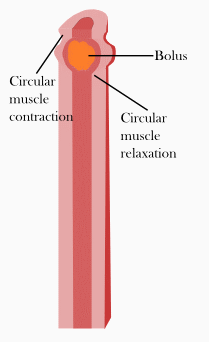peristalsis
The term peristalsis (from Greek : peri "around" and placein " get going ") describes the muscular activity of various hollow organs:
- Gullet ( esophagus ), stomach, and intestines
- Ureter ( ureter ), fallopian tube and uterus
- simple heart shapes in animals (insects, fish) or during the development of the heart (cardiac genesis).
to form
Propulsive peristalsis
Propulsive peristalsis involves ring-shaped constricting contractions of the smooth muscles , which continue in one direction and thus serve to transport the contents. Peristalsis is based partly on an intrinsic rhythm of the muscles (especially in the stomach and ureter) and partly on local reflexes (especially in the intestine: peristaltic reflex ). In addition, the peristalsis is promoted by the parasympathetic and inhibited by the sympathetic .
Non-propulsive peristalsis
The non-propulsive peristalsis of the intestine, also known as "segmentation", serves in particular to mix the intestinal contents.
Retrograde peristalsis
A retrograde peristalsis is found as a transport movement in the opposite direction in the esophagus in vomiting and for ruminants , but physiologically in the large intestine, where it is used to chair storage.
In contrast to the more even peristalsis of the small intestine, the contents of the large intestine are driven by periodic mass movements. They occur in the colon about one to three times a day and push the intestinal contents to the rectum . These mass movements can be triggered by the gastrocolic reflex .
Hormones and neurotransmitters
Hormones and neurotransmitters that affect peristalsis are:
- Acetylcholine ,
- Bombesin
- Cholecystokinin , stimulates the propulsive motor function of the small intestine and large intestine and the contraction and thus emptying of the gallbladder
- Endothelin 1-3
- Gallant
- Gastrin , leads to tonic contractions of the stomach (corpus and antrum) and the lower esophagus sphincter , thus causing faster gastric emptying and increased motility of the small and large intestines
- Gastrin releasing peptides
- histamine
- Inulin
- Neurokinin A and Neurokinin B
- Pancreatic polypeptide
- Prostaglandin E and Prostaglandin F
- Serotonin stimulates the intestinal peristalsis
- Substance P
Investigation methods
- With the ear on the belly one can hear chuckling and rumbling (bowel noise, "bowel growling").
- With the stethoscope on your stomach you can hear the intestinal noises more intensely.
- You can see the movement with an ultrasound machine.
- After a sip of X-ray contrast agent, you can see the movement with the X-ray machine.
- Magnetic marker monitoring
Decreased peristalsis
Peristalsis is reduced and there is a motility disorder :
- When the body is focused on performance, it largely switches off gastrointestinal activity (mainly through the release of adrenaline and noradrenaline)
- if inflammation in the abdominal cavity ( peritonitis ) paralyzes the intestinal muscles
- when giving butylscopolamine bromide (e.g. Buscopan ) or glucagon .
Symptoms of a dysmotility of the bowel include vomiting, a bloated stomach and a lack of bowel movements. If the peristalsis has completely stopped, one speaks of a paralytic ileus (syn. Intestinal atony).
Increased peristalsis
The peristalsis is increased:
- when eating food through the mouth (this leads to an increase via a reflex arc and hormone release)
- in rest phases
- when walking slowly
- a mechanical obstacle in the intestine leads to increased peristalsis in the area in front of it
- after the administration of pyridostigmine
- after taking caffeine
See also
Antiperistalsis , peristaltic pump
Web links
Individual evidence
- ↑ Harald Genzwürker, Jochen Hinkebein: Case book anesthesia, intensive care medicine and emergency medicine. Georg Thieme, Stuttgart / New York 2005, ISBN 3-13-139311-4 , pp. 19 and 136 f.
